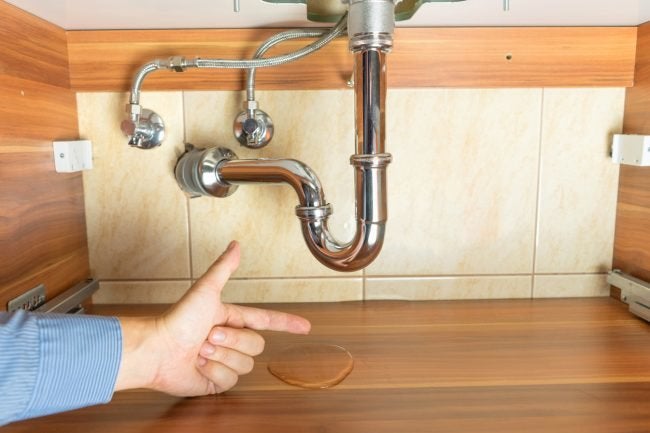Exactly how to Discover and Repair Water Leaks-- A Comprehensive Guide
Exactly how to Discover and Repair Water Leaks-- A Comprehensive Guide
Blog Article
Were you trying to find guidance about Top leak detection hacks?

Early detection of dripping water lines can mitigate a possible disaster. Some little water leakages might not be noticeable.
1. Analyze the Water Meter
Every residence has a water meter. Examining it is a proven manner in which aids you find leakages. For beginners, turn off all the water sources. Ensure no one will purge, use the faucet, shower, run the washing device or dish washer. From there, most likely to the meter and watch if it will certainly alter. Because no one is using it, there must be no motions. If it moves, that shows a fast-moving leak. Furthermore, if you discover no changes, wait an hour or two and check back once more. This suggests you may have a slow-moving leak that can also be underground.
2. Inspect Water Intake
Analyze your water costs and also track your water usage. As the one paying it, you need to see if there are any kind of discrepancies. If you spot sudden changes, despite your usage being the same, it suggests that you have leaks in your plumbing system. Bear in mind, your water expense should fall under the same variety each month. An unexpected spike in your costs suggests a fast-moving leakage.
On the other hand, a consistent boost on a monthly basis, despite having the exact same habits, reveals you have a sluggish leak that's additionally gradually escalating. Call a plumber to extensively inspect your residential property, particularly if you feel a cozy area on your flooring with piping underneath.
3. Do a Food Coloring Examination
When it pertains to water consumption, 30% originates from commodes. Test to see if they are running appropriately. Drop flecks of food color in the storage tank and wait 10 mins. If the color in some way infiltrates your bowl during that time without flushing, there's a leakage in between the storage tank and dish.
4. Asses Outside Lines
Don't fail to remember to check your outside water lines as well. Needs to water permeate out of the link, you have a loosened rubber gasket. One small leakage can lose loads of water as well as surge your water expense.
5. Assess the scenario and also evaluate
Home owners should make it a routine to inspect under the sink counters as well as also inside cupboards for any kind of bad odor or mold development. These two warnings indicate a leak so timely focus is called for. Doing routine evaluations, also bi-annually, can save you from a major issue.
Examine for discolorations and damaging as many devices as well as pipelines have a life span. If you suspect dripping water lines in your plumbing system, don't wait for it to intensify.
Early detection of leaking water lines can mitigate a prospective disaster. Some small water leaks may not be noticeable. Inspecting it is a guaranteed way that assists you uncover leaks. One tiny leakage can waste heaps of water as well as increase your water expense.
If you suspect leaking water lines in your plumbing system, do not wait for it to intensify.
How to Know If Your Home Has a Hidden Leak
Water Meter Reveals Inexplicable Water Usage
If you’d like to test whether or not there’s a leak somewhere in your home, you can do this using your water meter. Here is how to conduct the test:
Don’t use any water in your home for at least 30 minutes; this also means not turning on faucets or water-using appliances.
Go outside, and check your water meter for activity.
If your water meter shows that there was activity, even though no one was using any water, this proves that there is a leak in your home.Visible Mold or Mildew Growth
Leaks behind walls create moist, dark environments that allow mold and mildew to grow and thrive. Eventually, you might see mold growth forming on the wall closest to a hidden leak.
If mold is growing in an area that receives a high amount of moisture, such as a bathroom, it may simply be an indication that better ventilation is needed. However, if you see mold growth on a wall or the ceiling in an area where you would not expect, you probably have a hidden leak.
Musty, Mildew Odor
Sometimes you might not be able to see the mold or mildew that is growing as a result of a leak. However, the smell can give the problem away just as easily. If you catch a whiff of something musty, there’s a good chance that old water is collecting somewhere in your home that you can’t see.
Stained/Warped Walls, Ceilings, or Floors
When your home soaks up water, a variety of red flags can become visible, including ceiling stains, bubbling drywall, warped walls, and sagging floors. While these issues can be caused by excess humidity, they can also be signs that a pipe or plumbing connection has started leaking behind your walls.
Inexplicably High Water Bill
After a while, you get a general sense for what your water bill should be. If you own a pool or sprinkler system, your bill will tend to be higher during summer. However, if you receive a water bill that seems especially high, and you can’t figure out what caused it, then you may have a hidden leak somewhere that’s increasing your bill.
https://www.plumbingjoint.com/blog/2019/july/how-to-know-if-your-home-has-a-hidden-leak/

We had been shown that article on Finding hidden leaks from an associate on a different site. I beg you take a moment to promote this article if you appreciated it. I praise you for your time. Visit us again soon.
Report this page